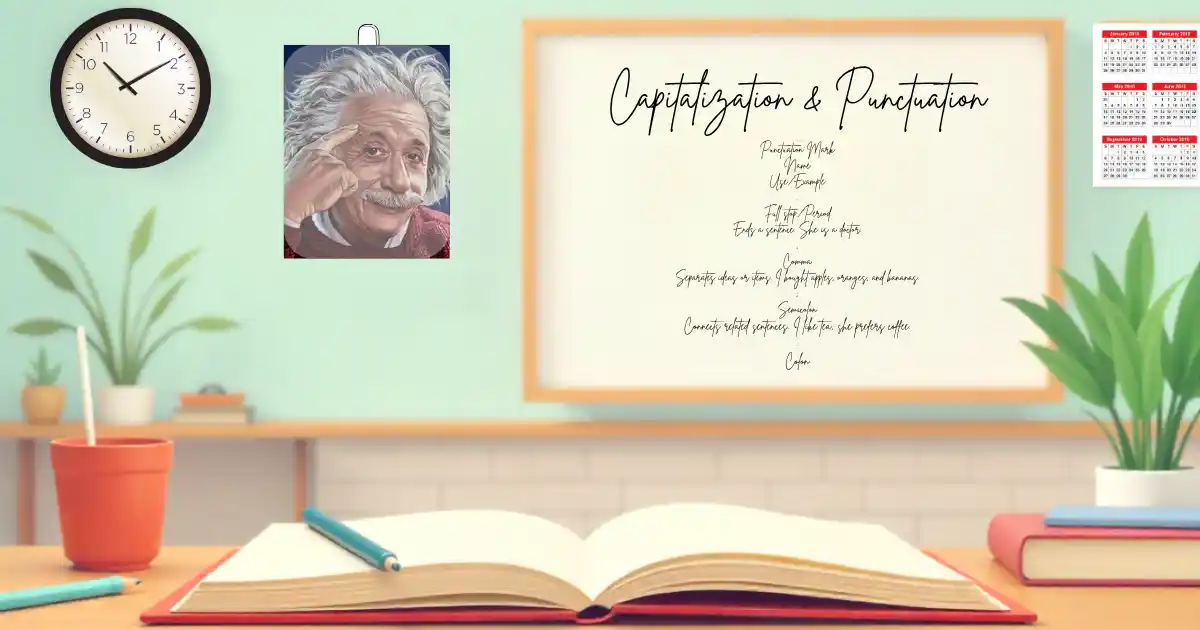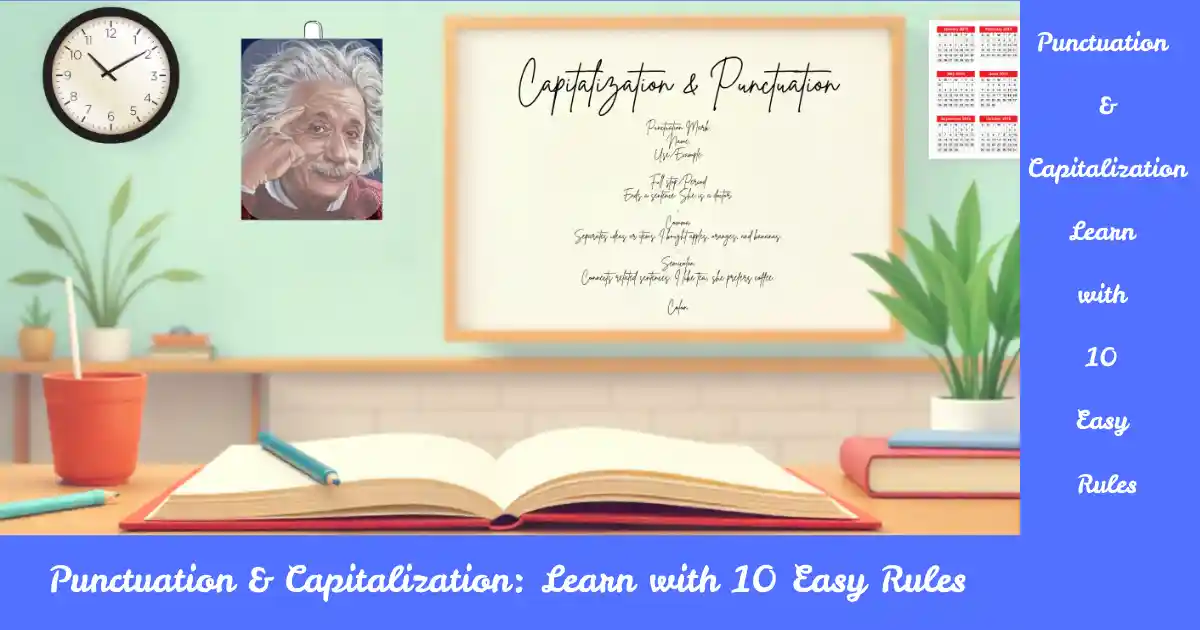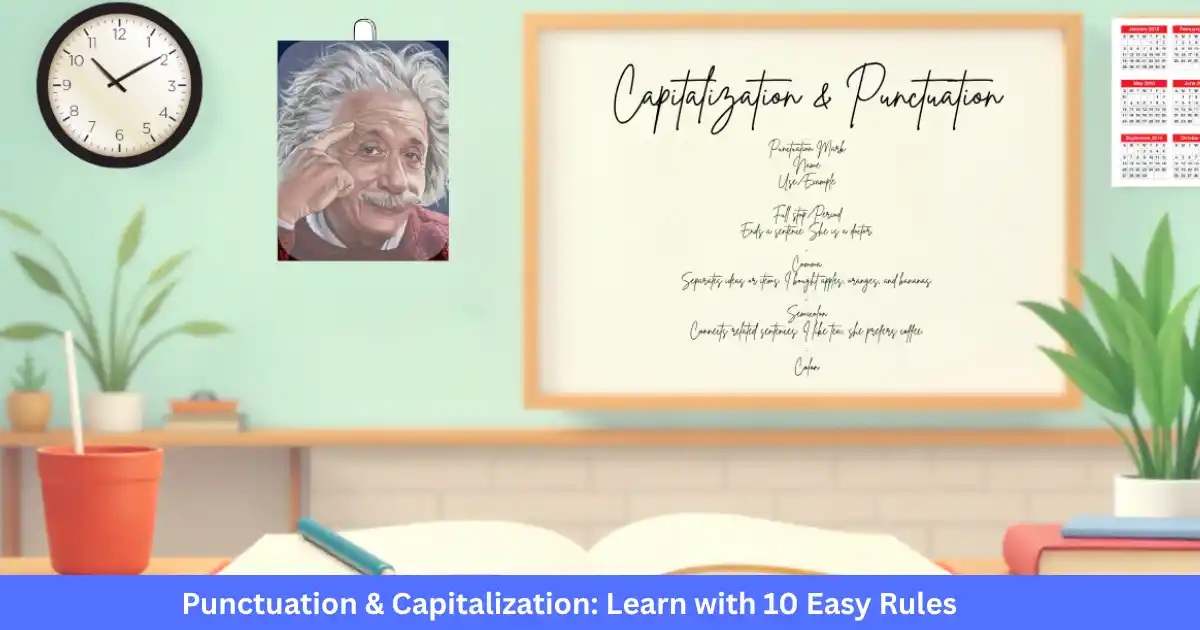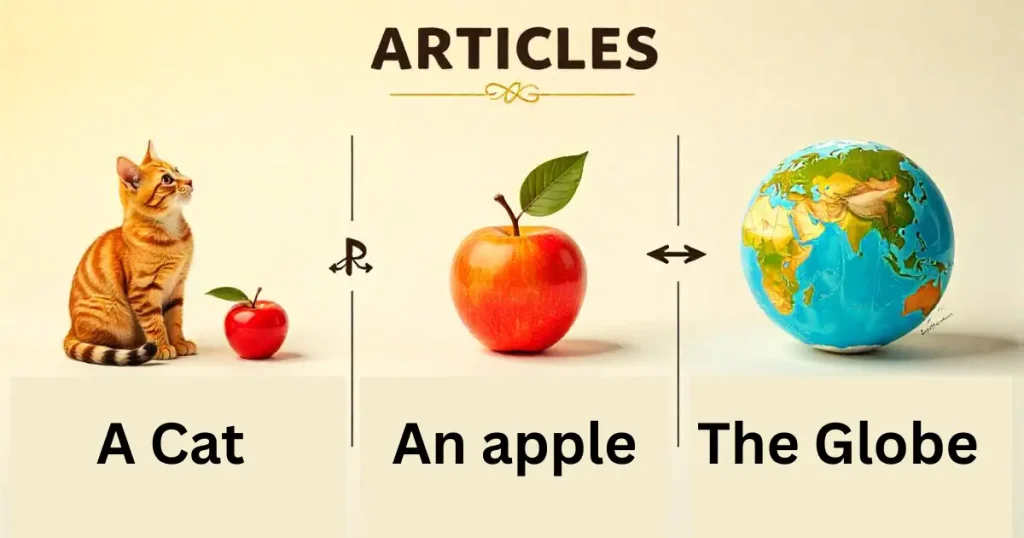Punctuation and capitalization are two of the most essential parts of English writing. They give sentences proper structure, rhythm, and clarity. Without punctuation marks, a sentence may look confusing or misleading. Similarly, without capitalization, writing looks careless and unprofessional.

In this guide, we’ll learn what punctuation and capitalization mean, why they are important, and how to use them correctly with clear examples.
Best 10 Rules of Degrees in English Grammar
What is Punctuation?
Punctuation refers to the marks used in writing to separate sentences and clarify meaning. These marks show the reader where to pause, stop, or give emphasis.
Example:
- Without punctuation: Let’s eat grandpa.
- With punctuation: Let’s eat, grandpa!
The comma completely changes the meaning — punctuation literally saves lives!
In short, punctuation helps make your writing meaningful, organized, and easy to read.
Importance of Punctuation in Writing
Punctuation plays a vital role in conveying the exact meaning of a sentence. Here are some key reasons why punctuation is important:
✅ It helps avoid confusion.
✅ It separates ideas clearly.
✅ It shows emotions or tone (exclamation mark, question mark).
✅ It gives a rhythm or flow to writing.
✅ It enhances professionalism and readability.
Proper punctuation ensures that your message is not misunderstood by the reader.
Common Types of Punctuation Marks and Their Uses
| Punctuation Mark | Name | Use/Example |
| . | Full stop/Period | Ends a sentence. She is a doctor. |
| , | Comma | Separates ideas or items. I bought apples, oranges, and bananas. |
| ; | Semicolon | Connects related sentences. I like tea; she prefers coffee. |
| : | Colon | Introduces a list or explanation. She brought: bread, milk, and eggs. |
| ? | Question mark | Ends a question. How are you? |
| ! | Exclamation mark | Expresses emotion. Wow! That’s amazing! |
| ‘ | Apostrophe | Shows possession or contraction. Raju’s book; it’s raining. |
| “ ” | Quotation marks | Enclose spoken or quoted words. He said, “I am ready.” |
| ( ) | Parentheses | Add extra information. She came (after the meeting). |
| – | Hyphen | Joins words. Well-known author. |
| — | Dash | Adds emphasis or a pause. He was tired — really tired. |

Top 3 Powerful Poems on Dreams: Wordsworth, Lawrence & Hughes
Usage of Punctuation
The Comma (,)
(a) Joining Clauses
- If two clauses share the same subject, don’t use a comma.
- If they have different subjects, use a comma before “and,” “but,” “or.”
✅ Example:
- They were friendly and invited us back.
- The restaurant was far from the city centre, but we decided to go there.
(b) Before Subordinate Clauses
✅ Example:
- If you work hard, you will succeed.
- Since he was ill, he did not come.
- Though he worked hard, he failed.
(c) In a Series (Listing Items)
✅ Example:
- She bought apples, oranges, bananas, and grapes.
- They’ve got apples, pears, bananas, and peaches. (American English uses a comma before “and.”)
(d) With Sentence Connectors
✅ Example:
- It doesn’t suit you, to be honest.
- Unfortunately, the proposal was rejected.
- I, therefore, hope you will consider my request.
(e) With Question Tags
✅ Example:
- He is playing football, isn’t he?
- You live in Savar, don’t you?
(f) With Vocatives or Interjections
✅ Example:
- Open the door, Rahim.
- Wow, what a beautiful bird!
- Allah, give us peace.
(g) With Reported Speech
✅ Example:
- He said, “Now it’s time for big changes.”
- “I’m too old for that,” she said.
(h) In Letters
✅ Example:
- Dear Rumi,
- Yours sincerely,
(i) In Numbers
✅ Example:
- 7,340 = Seven thousand three hundred and forty
Exercise – 1
Put commas where necessary:
At the railway station Atik bought a story book a trouser a pencil and a dictionary. The book which he bought is very informative. Soon the train blew the whistle for leave. We ran fast but couldn’t catch the train. As the station was crowded we decided to leave as soon as possible.
The Semicolon ( ; )
The semicolon (;) is a punctuation mark that shows a stronger pause than a comma but weaker than a full stop.
It connects closely related ideas or separates items in a complex list.
(a) Joining Related Clauses
Use a semicolon to connect two independent clauses that are closely related in meaning, without using a conjunction (like and, but, so).
Example:
- I like tea; she prefers coffee.
- The sky is cloudy; it might rain soon.
- He didn’t study hard; therefore, he failed the exam.
Tip: Both sides of a semicolon must be complete sentences.
(b) Before Conjunctive Adverbs or Linking Phrases
When a linking adverb (however, therefore, moreover, consequently, etc.) connects two sentences, use a semicolon before it and a comma after it.
Example:
- I wanted to go out; however, it started raining.
- She was late; therefore, she missed the train.
- He worked hard; as a result, he got the promotion.
(c) In Complex Lists
Use semicolons to separate items in a list when each item already contains commas.
This helps avoid confusion and makes the list clearer.
Example:
- On our trip, we visited Dhaka, Bangladesh; Kolkata, India; and Kathmandu, Nepal.
- The conference had speakers from London, England; Paris, France; and Rome, Italy.
(d) To Balance Ideas or Contrast
A semicolon can join two contrasting ideas that are balanced or compared in a sentence.
Example:
- To err is human; to forgive is divine.
- He is poor; she is rich.
- Some people dream; others act.
(e) To Avoid Overuse of Conjunctions
When several related clauses appear in one sentence, semicolons help separate them neatly without too many “and” or “but.”
Example:
- He came early; he worked sincerely; he left late.
- The teacher entered; the students stood up; the class began.
Exercise 2
Put semicolons where necessary:
He wanted to travel to several cities London Paris and Rome but his budget was limited.
Rumi is hardworking she always completes her assignments on time.
It was a long day we were tired we went straight to bed.
He didn’t enjoy the movie however his friends loved it.
The menu includes rice fish curry and salad bread butter and jam milk tea and coffee.
The Colon ( : )
A colon ( : ) is used to introduce, explain, or emphasize something that follows. It often signals that what comes next illustrates or completes the previous part of the sentence.
(a) To Introduce a List
Example:
There are four skills in English: listening, speaking, reading, and writing.
You will need the following items: a notebook, a pen, and a dictionary.
📝 Note: Don’t use a colon right after a verb or preposition.
❌ Wrong: The things I like are: music, reading, and traveling.
✅ Right: I like three things: music, reading, and traveling.
(b) To Introduce an Explanation or Example
Example:
He got what he worked for: success.
There’s one thing she cannot tolerate: dishonesty.
She had only one wish: to see her son become a doctor.
(c) Before a Quotation
Example:
The teacher said: “Honesty is the best policy.”
He reminded us of a famous saying: “Time and tide wait for none.”
(d) To Emphasize or Clarify a Point
Example:
Remember this: hard work always pays off.
There is only one solution: we must start again.
One thing is certain: they will never give up.
(e) In Formal Letters (After Salutation)
Example:
Dear Sir:
To Whom It May Concern:
📝 Note: British English prefers a comma (,) after the salutation, while American English often uses a colon (:).
(f) In References, Ratios, and Time
✅ Example:
- Bible reference: John 3:16
- Ratio: The ratio of men to women was 3:1.
- Time: The train leaves at 6:45.
Exercise 3
👉 Insert colons ( : ) where necessary:
My father said Knowledge is power.
There are three primary colours red blue and yellow.
He has one goal to become a successful teacher.
The notice read Attention Students must bring their ID cards.
Remember this honesty always wins.
The Period / Full Stop ( . )
A period ( . ), also called a full stop, is the most common punctuation mark in English.
It is used to end a complete sentence, indicate abbreviations, and show indirect speech or initials.
Let’s explore its main uses 👇
(a) To End a Statement (Declarative Sentence)
✅ Example:
He is a good student.
The sun rises in the east.
Bangladesh is a beautiful country.
📝 Tip:
Every sentence that makes a statement — not a question or exclamation — ends with a period.
(b) After Abbreviations
✅ Example:
Dr. Rahman is our family physician.
He lives in Dhaka, Bangladesh.
The meeting was held at 10 a.m.
📝 Note:
In British English, some abbreviations don’t take a period (e.g., Dr, Mr, Mrs).
In American English, periods are more commonly used (Dr., Mr., Mrs.).
(c) After Initials and Titles
✅ Example:
J. K. Rowling wrote the Harry Potter series.
A. R. Rahman is a famous musician.
Prof. Karim will deliver the lecture today.
(d) In Indirect or Reported Speech
✅ Example:
He said that he was tired.
The teacher told us that honesty is the best policy.
Mother said that she was cooking.
(e) In Decimal Numbers and Currency
✅ Example:
The cost of the book is $12.50.
The height of the boy is 5.7 feet.
Bangladesh’s GDP grew by 6.4% last year.
(f) In Web Addresses and Email IDs
✅ Example:
Visit our website at www.sopnokotha.com.
Send your message to info@example.com.
✏️ Exercise 4
👉 Put periods ( . ) where necessary:
- Dr Ahmed is a famous heart specialist
- The river Padma flows calmly during winter
- The meeting will start at 9 a m
- R N Tagore was a great poet
- He said that he would come soon
The Question Mark ( ? )
A question mark ( ? ) is used at the end of a sentence that asks a direct question.
It signals curiosity, doubt, or inquiry — something that seeks an answer.
Let’s learn how and when to use it properly 👇
(a) After Direct Questions
✅ Example:
What is your name?
Where do you live?
Are you coming to the party?
Did he pass the exam?
📝 Tip:
A question mark replaces a period at the end of any interrogative sentence.
(b) In Tag Questions
✅ Example:
He is your brother, isn’t he?
You like mangoes, don’t you?
They aren’t late, are they?
📝 Note:
A tag question confirms or checks information, so it must end with a question mark.
(c) In Rhetorical Questions
✅ Example:
Who doesn’t want to be happy?
What is life without dreams?
Isn’t it a wonderful day?
📝 Tip:
Rhetorical questions don’t need answers — they express feelings or opinions.
(d) In Polite or Indirect Questions (Special Rule)
✅ Example:
Could you tell me where he lives?
Do you know when the train will arrive?
📝 Important:
If the main sentence is not a question but contains an indirect question, you do not use a question mark.
❌ Wrong: Could you tell me where he lives?
✅ Right: Could you tell me where he lives. (← No!)
✅ Actually Correct: Could you tell me where he lives? (← Because the whole sentence is still a question.)
Let’s compare:
- Direct question: Where does he live? → Ends with “?”
- Indirect question inside statement: I asked where he lived. → No question mark
(e) When Expressing Doubt in Writing
✅ Example:
He was born in 1975 (?)
The painting was probably by Leonardo da Vinci (?)
📝 Tip:
A question mark in parentheses (?) shows uncertainty or doubt about a fact or date.
✏️ Exercise 5
👉 Put question marks (?) where necessary:
Isn’t it a beautiful evening
What is your favourite colour
Can you help me with this problem
Who broke the glass window
He asked if I could lend him my book
The Exclamation Mark ( ! )
An exclamation mark ( ! ) is used to show strong feelings, surprise, joy, anger, or any sudden emotion.
It makes a sentence more expressive and emotional.
Let’s look at its main uses 👇
(a) After Exclamatory Sentences
✅ Example:
What a beautiful view!
How wonderful the day is!
What an amazing idea!
How fast he runs!
📝 Tip:
Exclamatory sentences begin with What or How and always end with an exclamation mark.
(b) After Interjections
✅ Example:
Wow! That’s incredible!
Alas! He has failed again.
Hurrah! We have won the match.
Oh! I forgot my wallet.
📝 Note:
Interjections like Wow, Alas, Hurrah, Oh, Bravo, Ah, etc., express emotions and are always followed by an exclamation mark.
(c) To Show Strong Emotion in Commands or Statements
✅ Example:
Stop! Don’t go there!
Leave me alone!
Come here right now!
That’s unbelievable!
📝 Tip:
Be careful not to overuse (!) in formal writing — use it mainly in dialogue or emotional contexts.
(d) To Express Surprise, Shock, or Sarcasm
✅ Example:
You did it all by yourself!
She forgot her own birthday!
Oh no! I missed the last train.
That was a brilliant idea — not!
(e) After Wishes, Greetings, or Farewells
✅ Example:
Happy birthday!
Congratulations!
Good luck!
Farewell, my friend!
✏️ Exercise 6
👉 Put exclamation marks (!) where necessary:
Oh I can’t believe my eyes
What a nice flower
Alas he is no more
Hurrah we have won
Stop don’t move
Quotation Marks ( “ ” )
Quotation marks, also known as inverted commas, are used to enclose direct speech, quotations, titles, or special words.
They help the reader see exactly what someone said or which words are being highlighted.
There are two types of quotation marks:
- Double quotation marks (“ ”) — more common in American English
- Single quotation marks (‘ ’) — more common in British English
Let’s explore their main uses 👇
(a) To Enclose Direct Speech
✅ Example:
He said, “I am going to school.”
“I will call you later,” she replied.
Father asked, “Did you finish your homework?”
📝 Note:
Use a comma before the opening quotation and a period, comma, question mark, or exclamation mark inside the quotes — depending on the sentence.
(b) When Quoting Someone’s Exact Words
✅ Example:
The teacher said, “Honesty is the best policy.”
Mother always reminds me, “Work hard and stay humble.”
The notice read, “Examination starts from Monday.”
(c) For Titles of Short Works
✅ Example:
I have read “The Happy Prince” by Oscar Wilde.
We watched “The Lion King” yesterday.
Have you heard the poem “Daffodils”?
📝 Tip:
Use quotation marks for short works (poems, songs, short stories, chapters).
For books, films, and magazines, use italics instead (e.g., Pride and Prejudice, Time Magazine).
(d) For Quoting Within a Quotation (Nested Quotation)
✅ Example:
He said, “I heard her say, ‘I’m not interested.’”
The guide explained, “The sign ‘No Entry’ means you can’t go beyond this point.”
📝 Rule:
When you quote someone inside another quote, use single quotation marks (‘ ’) inside double quotation marks (“ ”).
(e) To Highlight a Specific Word or Phrase (Irony or Special Meaning)
✅ Example:
The “smart” boy forgot his own name.
He was the “leader” no one followed.
The teacher said the word “photosynthesis” very clearly.
📝 Note:
Use quotation marks around a word to show irony, sarcasm, or to highlight it as a term.
(f) With Punctuation
✅ Example:
He asked, “Are you coming?”
“Be honest,” said the teacher.
“Stop!” she shouted.
📝 Rule:
- In American English, punctuation (., !, ?, ,) usually goes inside the quotation marks.
- In British English, punctuation goes outside unless it’s part of the quoted material.
✏️ Exercise 7
👉 Insert quotation marks (“ ”) where necessary:
Have you read the poem The Solitary Reaper
The teacher said Honesty is the best policy
Father said I am proud of you my son
Did she really say I don’t care
The notice read Keep the campus clean
The Apostrophe ( ’ )
An apostrophe ( ’ ) is used to show possession or to indicate missing letters in contractions.
It helps make writing shorter and more natural, especially in spoken English forms.
Let’s understand how it works 👇
(a) To Show Possession (Belonging)
✅ Example:
Rafi’s book is on the table.
The girl’s bag is new.
My father’s car is very old.
📝 Rule:
Add ’s after a singular noun to show possession.
For plural nouns ending in -s, add only an apostrophe ( ’ ):
✅ Example:
The teachers’ room is upstairs.
The boys’ hostel is clean.
For irregular plurals (not ending in -s), add ’s:
✅ Example:
The children’s toys are new.
The men’s room is next door.
(b) To Show Omission of Letters (Contractions)
✅ Example:
I’m = I am
He’s = He is / He has
They’re = They are
Can’t = Cannot
Don’t = Do not
It’s = It is
📝 Tip:
Be careful with “its” and “it’s” —
- its = possessive (The cat licked its paw.)
- it’s = contraction of it is (It’s a sunny day.)
(c) To Show Time or Quantity Relationships
✅ Example:
A day’s work
A week’s holiday
Two years’ experience
Ten minutes’ walk
📝 Rule:
Use the apostrophe to show how long something lasts or relates to time or quantity.
(d) In Plural Forms of Letters or Symbols (Rare Use)
✅ Example:
Mind your p’s and q’s.
There are two a’s in “banana.”
Don’t forget to dot your i’s.
📝 Note:
Avoid using apostrophes for normal plurals (e.g., cats, books, pens ✅ not cat’s, book’s, pen’s ❌).
✏️ Exercise 8
👉 Put apostrophes ( ’ ) where necessary:
- The boys hostel is very big
- My mothers phone is lost
- Its a beautiful day
- I cant remember his name
- The childrens playground is large
The Dash ( — )
A dash ( — ) is used to create a strong break in a sentence.
It adds emphasis, sudden change, or extra information in a more dramatic or informal way than commas or parentheses.
There are two main types of dashes:
- Em dash (—) — used in writing to separate or emphasize parts of a sentence.
- En dash (–) — used to show ranges (like 2010–2020, pages 5–10).
Let’s focus on the Em Dash (—) here 👇
(a) To Show a Sudden Change of Thought
✅ Example:
I was about to call you—oh, there you are!
She wanted to explain—but he walked away.
I thought it was going to rain—but it didn’t.
📝 Tip:
The dash can replace a comma or parentheses for a sudden pause or interruption.
(b) To Add Extra Information or Emphasis
✅ Example:
My best friend—who lives in Canada—called me yesterday.
Everything we saw—the lights, the music, the people—was magical.
Only one thing mattered—victory.
📝 Rule:
You can use two dashes (— —) to set off a phrase in the middle of a sentence, similar to parentheses.
(c) To Replace a Colon for Dramatic Effect
✅ Example:
He got what he wanted—success.
There’s one thing I can’t stand—dishonesty.
She knew what she had to do—run.
📝 Tip:
A dash can replace a colon ( : ) when you want a more emotional or impactful pause.
(d) To Indicate Interrupted Speech in Dialogue
✅ Example:
“I was going to say—” “Don’t even start!”
“But I thought—” “No excuses!”
“Well, if you just let me—” “Enough!”
📝 Rule:
Use a dash at the end of a sentence to show that the speaker was cut off or stopped suddenly.
(e) To Show Ranges (Using En Dash –)
✅ Example:
The Dhaka–Chittagong train leaves at 7:30.
The meeting will be held from 3–5 p.m.
The years 2010–2020 were crucial for digital growth.
📝 Note:
Don’t confuse the em dash (—) with the en dash (–).
- Em dash (—) → separates or emphasizes parts of a sentence.
- En dash (–) → shows range or connection between numbers, places, or dates.
✏️ Exercise 9
👉 Insert dashes (—) where necessary:
Only one thing mattered hard work
I was about to call you oh there you are
Everything we saw the lights the music the people was exciting
He got what he wanted peace
I was saying but he didn’t listen
Summary
| Punctuation | Symbol | Key Use |
| Full Stop | . | End of a sentence |
| Comma | , | Pause, separation |
| Semicolon | ; | Join related clauses |
| Colon | : | Introduce a list/explanation |
| Apostrophe | ’ | Possession, omission |
| Question Mark | ? | End of a question |
| Exclamation Mark | ! | Strong emotion |
| Quotation Marks | “ ” | Speech or quotation |
| Dash/Hyphen | — / – | Extra info or compound words |
| Brackets | ( ) | Additional info |

Usage of Capitalization
(a) Beginning of a Sentence
✅ Example:
- Once there was a hare.
(b) At the Start of Poems or Quotations
✅ Example:
- Tick, tock! Tick, tock!
- Merrily sings the clock.
(c) Direct Speech
✅ Example:
- Father said, “Go to school.”
(d) Proper Nouns & Titles
✅ Example:
- 16 December is the Victory Day of Bangladesh.
- Pride and Prejudice by Jane Austen.
(e) Proper Adjectives
✅ Example:
- I like Bangladeshi food.
Common Mistakes in Punctuation and Capitalization
Even advanced learners often make small but serious mistakes in these areas. Here are some examples:
🚫 i am a teacher. → ✅ I am a teacher.
🚫 what a beautiful day → ✅ What a beautiful day!
🚫 raju said i am fine. → ✅ Raju said, “I am fine.”
🚫 He lives in dhaka. → ✅ He lives in Dhaka.
👉 Remember: A sentence must start with a capital letter and end with a punctuation mark.
Conclusion
Punctuation and capitalization are the foundation of clear English communication. Whether you are writing an academic essay, a business email, or a social media post, using them correctly shows your language proficiency and professionalism. Practice regularly, and you’ll soon write with clarity and confidence.

